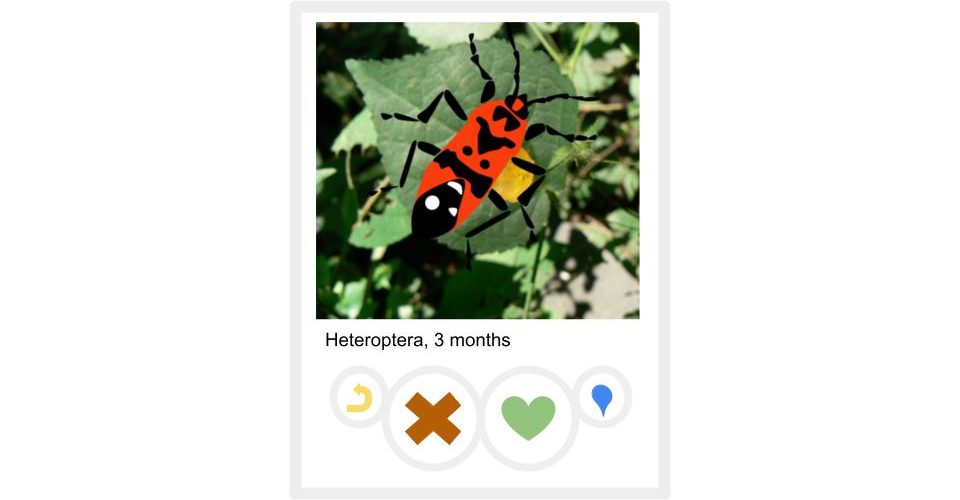Are you flirting with me? How the environment shapes insect sexual signals
Communication is key
Most of us have experienced the importance of communication in our relationships. We’ve recognised the importance of spelling out what we want and how we want it. Similarly, for a chance at mating, insects must have an effective means of communication. Often, their communication lines cover long distances and carry with them sufficient personal information to woo their mates.
Insects covey all sorts of information in their signals, which can be audible, chemical or tactile, including their sex, developmental stage, mating status and their suitability as a mate. These signals travel over long or short distances depending on the signalling method used. However, as many people on Tinder find, securing a mate goes beyond sending out signals. For insects, finding mating partners is largely dependent on the signal’s efficacy. Signals used in sexual communication have evolved to maximise efficient signal transfer, either reaching as many mates as possible or efficiently reaching that one special insect1. Let us take you through some of the main signals used by insects to find the perfect mate.
Chemical signals
Most insects communicate using chemical signals. They use these signals to attract mates, ward off predators or signal where there is food. Chemical signals, which can be both long-distance and intimately close, play specific roles in sexual selection2. For instance, pear sucker bugs produce semiochemicals that indicate the sex of the bug, thereby reducing same-sex mating3. Sometimes, chemicals released by other organisms create mating opportunities for insects. Like in the case of the broad bean plant, which releases volatile chemicals that attract the European tarnished bug. This chemical provides a vital mating opportunity for these bugs by cluttering them together on the plant4.
Stridulation
Stridulation is where one part of the body is rubbed against the other to produce sound usually by using a “scraper” and a “file”. It is a very common form of long-range communication in insects. The songs produced during stridulation are highly complex and are used to communicate throughout courtship and copulation. Stink bugs and assassin bugs produce enough songs to communicate a full relationship. Each song is unique and bears information on location, acceptance, rejection and rivalry during courtship5 6. While sound production helps insects to find their perfect mate, it has its drawbacks. Auditory signals sometimes expose insects to predators and might be compromised by interference with other songs in the environment, decreasing the effectiveness of their tune. Imagine trying to hum Taylor Swift and someone blasts Red Hot Chili Peppers, you wouldn’t know what to focus on. However, some bugs have adapted to overcome this. A good example is the stink bug. When two individuals call at the same time, males and females change the time parameters of their call to increase the frequency difference and avoid confusion7.
Abdominal vibration
These vibrations travel along the substrate that the individual is perched on; hence, it is a shorter range communication, one that is safe from eavesdroppers8 9. This method of communication is commonly found in smaller and softer insects that have a higher cost of sound production and might not be able to form sound-producing organs10. Vibrations are produced by rapid tremulation, releasing energy and creating waves, or percussive vibration, actually beating the substrate with the abdomen or wings. The success of this signal depends on the substrate as the wrong substrate could dampen the pathway and decay the signal. Harlequin bugs often live on cabbage, broccoli or kale plants11. The veins in these plants carry the vibration signals more efficiently than the head of the plant, and harlequin bugs are even able to estimate how far away the signaller is by the strength of the vibrations. As vibrations make no noise and don’t travel far, they are often safer from eavesdroppers than with other forms of communication, but not always. The parasitoid wasp can trace the female stink bug’s vibration signals to her eggs12. In water, vibration signals cause ripples, sending out signals to rivals mates and predators. Water striders have a special sense organ that can distinguish between the ripples of a predator and that of a potential mate; it’s very useful for avoiding dangerous situations13.
Antennation
Antennation is the grooming of a partner with antennae during courtship and mating. This form of communication is involved in the detection of chemical odours, localisation of vibratory signals, grooming and physical restraint during copulation. Because of the wide range of behaviours they can be involved in, antennae have evolved into complex shapes specific to their use. For instance, the antenna used to receive chemical signals are often larger and more filamentous than other types of antennae14 15. When close to an insect, antennation can be used in short-range communication, including tapping, vibrations and stroking16. This behaviour assesses an insect’s quality as a mate and their willingness to mate. It can also initiate mating. For instance, a male leaf-footed bug will gently antennate the female’s head, antennae, and abdomen with his antennae and front legs during courtship as a sign that he wants to mate and in response she allows the male to mate with her17. Some antennae are used in a more aggressive style of mating. Water striders antennae are wrench shaped with a spike that fits into the female’s groove, allowing him to hoist himself onto her18.
Patterns in the patter
Insects will find that the success of the signal that they send out will be impacted by their environment, which determines how well signals travel and are received. Insect behaviour, morphology and environmental factors such as climate, seasons, habitat structure, predators and prey determine how well signals travel and are received. Tailoring communication signals to specific environments has created behavioural diversity across many different species; however, there is a pattern. A broad pattern was discovered in an analysis of different types of habitats occupied by 76 families of True Bugs (Heteroptera) and the types of sexual signalling they used19. It was discovered that insects living on plants are more likely to use vibrational signalling, like stridulation or abdominal vibration, as are insects that live in water as the properties of water favour vibrational signals. Also, cryptic species, for instance, hidden in tree bark and leaf litter, are more likely to use chemical signals that can keep them hidden. Cryptic insects are more likely to use antennation than others.
For some of these signals, it is easy to see how they would arise under specific environmental conditions. For instance, vibrations travel easily through the water making it a perfect form of communication for this environment. However, sometimes the link between the signal and the environment is more difficult to see. But patterns CAN be found. Understanding how the environment shapes sexual signalling is important as our planet becomes more and more disrupted by climate change and this may be vital for the survival of species and their sex lives.
Specialist-edited by Patience Asanga
Copy-edited by Claire Thomson
References
- Signals, Signal Conditions, and the Direction of Evolution: The American Naturalist: Vol 139 (uchicago.edu)
- Chemical Communication in the True Bugs and Parasitoid Exploitation | SpringerLink
- Response of summerform pear psylla (Hemiptera: Psyllidae) to male- and female-produced odors | The Canadian Entomologist | Cambridge Core
- Vicia faba-Lygus rugulipennis interactions: induced plant volatiles and sex pheromone enhancement – PubMed (nih.gov)
- Different stridulatory vibrations during sexual behaviour and disturbance in the blood-sucking bug Triatoma infestans (Hemiptera: Reduviidae) – ScienceDirect
- Prosorrhyncha: Heteroptera and Coleorrhyncha – ScienceDirect
- Interference of Overlapping Insect Vibratory Communication Signals: An Eushistus heros Model. – Abstract – Europe PMC
- Frontiers | Predator-Prey Interactions and Eavesdropping in Vibrational Communication Networks | Ecology and Evolution (frontiersin.org)
- (PDF) Mate location in the southern green stink bug,Nezara Viridula (Heteroptera: Pentatomidae), mediated through substrate-borne signals on ivy | Damijana Ota – Academia.edu
- (PDF) Acoustic Communication in Neuropterid (researchgate.net)
- Vibratory signals of the harlequin bug and their transmission through plants – Čokl – 2004 – Physiological Entomology – Wiley Online Library
- Eavesdropping on sexual vibratory signals of stink bugs (Hemiptera: Pentatomidae) by the egg parasitoid Telenomus podisi – ScienceDirect
- Morphology and neurophysiology of tarsal vibration receptors in the water strider Aquarius paludum (Heteroptera: Gerridae) – PubMed (nih.gov)
- Function, Developmental Genetics, and Fitness Consequences of a Sexually Antagonistic Trait (science.org)
- (PDF) Sexual Communication with Pheromones (researchgate.net)
- Copulatory sequences and sexual struggles in millipedes. (cabdirect.org)
- https://academic.oup.com/aesa/article/93/4/972/22694
- Function, Developmental Genetics, and Fitness Consequences of a Sexually Antagonistic Trait (science.org)
- Environmental Correlates of Sexual Signaling in the Heteroptera: A Prospective Study – PMC (nih.gov)







